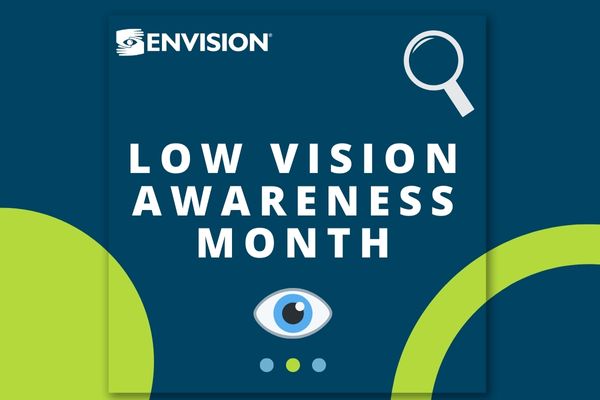Low Vision Awareness Month
By Beth Walker • Feb 02, 2024

Blog Content
This month is not only Low Vision Month, but it is also Retinitis Pigmentosa and Age-Related Macular Degeneration Month. We wanted to highlight these two different, but common low vision impairments as a part of Low Vision Awareness Month. What is the difference between these two? Retinitis Pigmentosa (RP) is often diagnosed in childhood or early adult life, while Age-Related Macular Degeneration (AMD) happens in older adults; In fact, it is the leading cause of vision loss for this age demographic. Just because these visual impairments are different from each other does not mean they are not significant. Knowing what you can do to prevent yourself from these impairments, or support someone who has them, is important to understand.
Retinitis Pigmentosa, or RP: what is it, and how does it happen?
RP refers to a group of retinal diseases, so there are different forms of RP that you can have. Among these are Usher Syndrome, Leber Congenital Amaurosis, and Bardet-Biedl Syndrome, which are the most common. It is typically diagnosed in children, adolescents or early adults. It is a progressive disorder, and the rate of vision loss will differ between people, but many people with RP are legally blind by age 40. The first symptoms of RP are often night blindness, decreased central vision, and loss of ability to discriminate between colors and details. Depending on the type of RP you have, the first symptoms to manifest will differ.
Around 100,000 people in the United States have RP. It is mainly caused by gene mutations that are passed down within families.There are dozens of these types of gene mutations that can be linked to RP, and it is recommended that if a family member has RP, other family members should have their eyes checked by an optometrist who specializes in detecting RP and retinal diseases. Genetic testing is also available to assess the risk of passing the gene mutations from parent to child. There is no treatment for RP, but there are many resources and rehabilitation programs Envision offers to help those with it to make the most of their vision. The best thing you can do to be preventative is getting your eyes checked regularly.
Age-Related Macular Degeneration, or AMD: what is it, and how does it happen?
AMD is a visual impairment that causes blurring in your central vision, and 11 million people in the United States have it. There are two types of it: Dry AMD, and Wet AMD. Dry AMD is when the macula gets thinner with age and progresses more slowly. With Wet AMD, blood vessels grow in the back of the eye and damage the macula - this type is less common. AMD is the leading cause of vision loss in older adults since both Wet and Dry AMD happen because of aging and its damage done to the macula. It does not cause complete blindness, but it can make it harder to do close-up work, drive, read, see people’s faces, and more.
The progression is different for each person, but there are 3 stages: early, intermediate, and late AMD. With early stages there are no symptoms, but with intermediate and late there can be blurriness, trouble seeing in low lighting, seeing blank spots, muted colors, and straight lines that start to look wavy (this is a warning sign for late AMD). The risk for AMD increases with age, and increases with smoking habits, high cholesterol and high blood pressure issues. There are no treatments for early AMD or for late Dry AMD, but there are treatment options for both intermediate and late Wet AMD, and for intermediate Dry AMD. It does not always happen in both eyes, and the best way to be preventative is to have your optometrist test you for AMD as part of your eye exam. Envision also offers resources and services to help those with AMD to maintain and make the most of the vision they have.
Low Vision Awareness Month is extremely important, and we want everyone to be aware of both Retinitis Pigmentosa and Age-Related Macular Degeneration and how they can affect people. If you are concerned about having either one of these visual impairments, the best thing you can do is attend your regular eye exams and ask to be tested for them.
If you are looking to help support a loved one who has RP or AMD, we also offer support groups and activities for anyone with blindness or visual impairments. Don’t forget to celebrate Low Vision Awareness month all the way through February (and all the time) and help share and spread the knowledge of low vision loss.